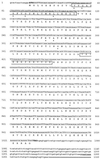A fruit-specific putative dihydroflavonol 4-reductase gene is differentially expressed in strawberry during the ripening process
- PMID: 9625725
- PMCID: PMC34992
- DOI: 10.1104/pp.117.2.711
A fruit-specific putative dihydroflavonol 4-reductase gene is differentially expressed in strawberry during the ripening process
Abstract
A cDNA clone encoding a putative dihydroflavonol 4-reductase gene has been isolated from a strawberry (Fragaria x ananassa cv Chandler) DNA subtractive library. Northern analysis showed that the corresponding gene is predominantly expressed in fruit, where it is first detected during elongation (green stages) and then declines and sharply increases when the initial fruit ripening events occur, at the time of initiation of anthocyanin accumulation. The transcript can be induced in unripe green fruit by removing the achenes, and this induction can be partially inhibited by treatment of de-achened fruit with naphthylacetic acid, indicating that the expression of this gene is under hormonal control. We propose that the putative dihydroflavonol 4-reductase gene in strawberry plays a main role in the biosynthesis of anthocyanin during color development at the late stages of fruit ripening; during the first stages the expression of this gene could be related to the accumulation of condensed tannins.
Figures






Similar articles
-
Cloning, expression and immunolocalization pattern of a cinnamyl alcohol dehydrogenase gene from strawberry (Fragaria x ananassa cv. Chandler).J Exp Bot. 2002 Aug;53(375):1723-34. doi: 10.1093/jxb/erf029. J Exp Bot. 2002. PMID: 12147722
-
Cloning and characterization of two ripening-related strawberry (Fragaria x ananassa cv. Chandler) pectate lyase genes.J Exp Bot. 2003 Feb;54(383):633-45. doi: 10.1093/jxb/erg065. J Exp Bot. 2003. PMID: 12554706
-
Cloning, molecular characterization and expression pattern of a strawberry ripening-specific cDNA with sequence homology to pectate lyase from higher plants.Plant Mol Biol. 1997 Aug;34(6):867-77. doi: 10.1023/a:1005847326319. Plant Mol Biol. 1997. PMID: 9290639
-
A strawberry fruit-specific and ripening-related gene codes for a HyPRP protein involved in polyphenol anchoring.Plant Mol Biol. 2004 Aug;55(6):763-80. doi: 10.1007/s11103-004-1966-4. Plant Mol Biol. 2004. PMID: 15604715
-
Expression analysis of a ripening-specific, auxin-repressed endo-1, 4-beta-glucanase gene in strawberry.Plant Physiol. 1998 Dec;118(4):1307-16. doi: 10.1104/pp.118.4.1307. Plant Physiol. 1998. PMID: 9847104 Free PMC article.
Cited by
-
Transcription-Associated Metabolomic Analysis Reveals the Mechanism of Fruit Ripening during the Development of Chinese Bayberry.Int J Mol Sci. 2024 Aug 8;25(16):8654. doi: 10.3390/ijms25168654. Int J Mol Sci. 2024. PMID: 39201345 Free PMC article.
-
FaQR, required for the biosynthesis of the strawberry flavor compound 4-hydroxy-2,5-dimethyl-3(2H)-furanone, encodes an enone oxidoreductase.Plant Cell. 2006 Apr;18(4):1023-37. doi: 10.1105/tpc.105.039784. Epub 2006 Mar 3. Plant Cell. 2006. PMID: 16517758 Free PMC article.
-
Study on cyanidin metabolism in petals of pink-flowered strawberry based on transcriptome sequencing and metabolite analysis.BMC Plant Biol. 2019 Oct 14;19(1):423. doi: 10.1186/s12870-019-2048-8. BMC Plant Biol. 2019. PMID: 31610785 Free PMC article.
-
Novel insight into vascular, stress, and auxin-dependent and -independent gene expression programs in strawberry, a non-climacteric fruit.Plant Physiol. 2002 Jul;129(3):1019-31. doi: 10.1104/pp.003558. Plant Physiol. 2002. PMID: 12114557 Free PMC article.
-
Physiological and Proteomic Approaches to Address the Active Role of Botrytis cinerea Inoculation in Tomato Postharvest Ripening.Microorganisms. 2019 Dec 11;7(12):681. doi: 10.3390/microorganisms7120681. Microorganisms. 2019. PMID: 31835786 Free PMC article.
References
-
- Baker ME, Blasco RE. Expansion of the mammalian 3β-hydroxysteroid dehydrogenase/plant dihydroflavonol reductase superfamily to include a bacterial cholesterol dehydrogenase, a bacterial UDP-galactose 4-epimerase, and open reading frames in vaccinia virus and fish lymphocystis disease virus. FEBS Lett. 1992;301:89–93. - PubMed
-
- Bavage AD, Davies IG, Robbins MP, Morris P. Expression of an Antirrhinum dihydroflavonol reductase gene results in changes in condensed tannin structure and accumulation in root cultures of Lotus corniculatus (bird's foot trefoil) Plant Mol Biol. 1997;35:443–458. - PubMed
-
- Beld M, Martin C, Huits H, Stuitje AR, Gerats AGM. Flavonoid synthesis in Petunia hybrida: partial characterization of dihydroflavonol-4-reductase. Plant Mol Biol. 1989;13:491–502. - PubMed
-
- Bongue-Bartelsman M, O'Neill SD, Tong Y, Yoder JI. Characterization of the gene encoding dihydroflavonol 4-reductase in tomato. Gene. 1994;138:153–157. - PubMed
Publication types
MeSH terms
Substances
Associated data
- Actions
LinkOut - more resources
Full Text Sources

